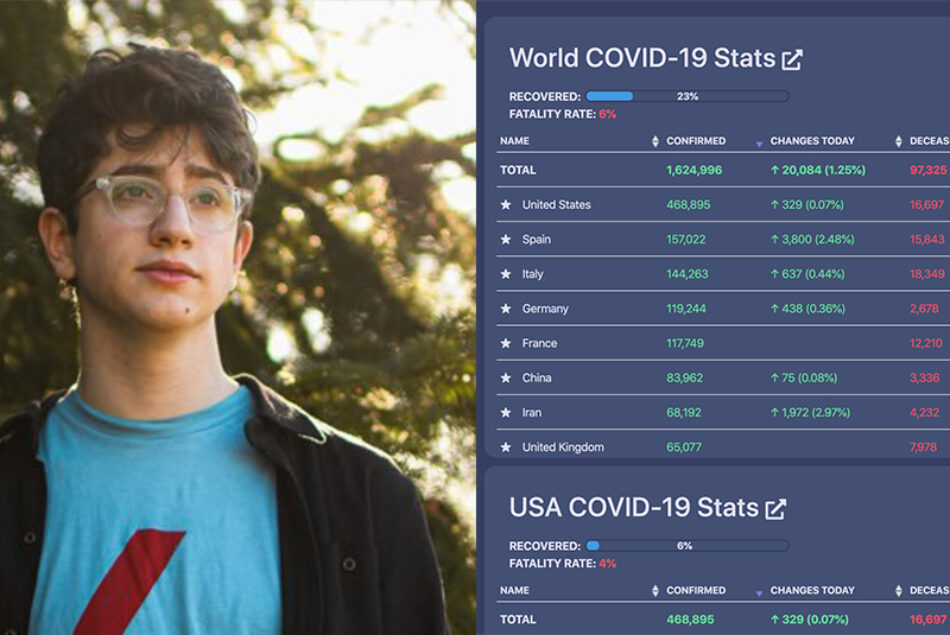How a 17-year-old Went Viral Through Online Learning & Collaboration

If you haven’t heard the name Avi Schiffmann yet, you will soon. He’s rapidly gaining celebrity for building ncov2019.live, an up-to-the-minute Coronavirus dashboard tracking COVID-19’s cases, casualties, and recoveries around the world.
In March, according to SimilarWeb, his website went from almost nothing to nearly breaking the top 1,000 overall sites in the U.S. It gets millions of visitors from around the world.
Here’s the kicker: Avi is 17 years old.
He’s a high-school student in Washington State who’s spent nearly every waking moment over the past few months developing what’s now one of the most comprehensive visuals for understanding this global crisis.
“I’m very tired,” Avi admitted over video chat with Brainly. “It’s a lot of work to maintain the website. I got 80,000 messages yesterday. Most emails are just people asking for a new feature or reporting some kind of bug or something like that. It’s a whole thing to deal with.”
Through months of learning and meticulous development, Avi has built an incredibly advanced project that has now helped millions of people around the world.
Not surprising was that his learning process happened at home from the very beginning, through searching for answers online and collaborating with digital communities.
Read on for our interview with Avi, transcribed from our call.
Q&A with Avi Schiffmann
How does your website work?
Avi: The website is very minimalistic. If you visit on a phone, you first see a quick fact section. Instantly, the numbers that you need are at a glance. Then you can scroll down and see individual breakdowns of places like the United States or Australia to get more in-depth information there, like how many people recovered. It all works by using a technology called web scraping.
What’s web scraping?
Avi: Let’s take Korea for example. I can go to a Korean government website, their version of the CDC. Let’s say they have a table of Coronavirus numbers there for their country. What I’m able to do is download that table every couple minutes or so. My site does this for basically all countries. And then there are some more in-depth views, like breakdowns of the United States.
Web scraping is a big pain to maintain. Tables change format often, which means you have to recode your scraper and fix new bugs. It’s a big hassle, but it’s gotten easier over time because more people have started to create APIs and things like that, which make it easier. But yeah, it’s a big effort to keep the numbers updating correctly and accurately every couple of minutes.
And there are people in so many countries that visit the website — when I’m sleeping, it’s daytime in Ethiopia and there are Ethiopians trying to visit my website. Let’s say there’s an issue with Ethiopia and I’m sleeping, then I wake up to hundreds of messages. It’s a whole thing making an international website. Only 50% of my traffic is from the United States.
How did this idea come about?
Avi: When I started, there were less than 1,000 total cases and they were all in the Wuhan area of China. I noticed it was really hard to find the information; if you wanted the most up-to-date numbers you’d have to go to local Chinese government websites or read news articles, but those were usually out of date by the time you read them. Eventually, the [World Health Organization] started publishing daily PDFs, but those were also out of date because numbers changed faster than that.
I thought I could do a better job, so I started working on something to make it easy to get the information. I also noticed that there was a lot of fake news being spread and I wanted to make my website free of political biases or advertisements or any of that kind of stuff.
How did you learn to do all of this?
Avi: I’ve been programming for about a decade by now. The first websites I made were in, like, second grade. I made stick figure animation hubs and random nonsense, I’ve made video games, apps, computer programs, all kinds of stuff.
Everything I know is by watching YouTube videos and searching up questions. For every question I have, there are 200 other people that have the same one. It’s pretty easy to find an answer related to most programming stuff online. I haven’t gone to college and didn’t do any special kind of boot camp, all I did was search it up.
Was this project more of an application of skills you already knew, or a product of learning a ton of new skills?
Avi: It was definitely the latter. This started as another project that I was working on to just learn more skills, like web scraping and array manipulation. It ended up becoming so much bigger than I ever thought it would be.
Half the stuff I did on the website I didn’t know before. One of the things I had to learn was basic Linux (an operating system) over the weekend to set up a server and I had never done any of that. So, I used many YouTube tutorials and all that kind of stuff out there. Stack Overflow is amazing.
It took me a couple of days to create the first original website, which was very basic compared to this one. I’ve been working on it since and it’s evolved over time.
How has the online community helped you?
Avi: There are a lot of people willing to contribute to coding the website. For a while, all of the code was open-source on GitHub, and there were a lot of people willing to contribute new features to the website for free. They just wanted me to know new stuff and would add things, so that was pretty cool for a while.
Jensen [an engineering collaborator he lists on his site] helps me all the time with developer kind of things. I met her online in a chatroom. For a while, I was doing it all myself and it was a lot of work, but she now does a lot of helpful computer programming that frees up my time to do more things like interviews and just think about something besides the website.
What would you say to another student who’s inspired by what you’re doing and wants to get started on a big idea of their own?
Avi: I think the best way to learn how to do things, even programming, is to create projects. Those tutorials that are, like, 14 hours long are terrible in my opinion. Search up questions and learn as you go along. I’ve made 30 websites in the past, many of which were projects I did just to learn new features.
I hope that what I created inspires lots of other young people to create something that can help not just the coronavirus but just stuff in general. There are so many great ways technology can be used.
On a lighter note, what are you doing to stay sane at home?
Avi: I play video games with my friends sometimes, it takes my mind off coronavirus stuff, but this is basically all I’ve been doing 24/7 for months. I’m very burnt out, very tired, but I can’t just step away from it all. The website has to continue to be maintained, there are so many opportunities, so many interviews, there are legal things, all kinds of nonsense…
Sometimes I wish I could just step away from it all because it’s just so much pressure and so much to do, but there are a lot of great opportunities that come from working on something this big. I wouldn’t say I’m as famous as, like, Taylor Swift or something, but the kind of media attention I’ve been getting is kind of crazy.
How has this project and its acclaim has impacted your future outlook? What’s your plan once this project ends?
Avi: I think this further motivates me to do what I wanted to do in the first place, which is to create really cool things. I don’t really care about making a generic internet company and selling it for like, 300 million dollars or something like that. One company I really like is Napster. They were a terrible company, they got sued by everyone who ever made music, but music has never been the same after Napster. Apple completely changed computers and smartphones. I want to do stuff like that.
I hope this project gives me the resources and connections to continue. There are millions of people waiting for the next thing I make, which gives me the motivation to just continue working. I hope I can take at least a week break till my next project though.
Conclusion
In a time where students are forced to turn to learning in an online setting, we’re heartened by this story of a high-school student using these resources to better both himself and the world around him.
There’s no doubt you’ll be seeing a lot more of Avi soon. In the meantime, go check out his website and show your thanks by buying him a coffee. He could use the caffeine.
Photo credit: Avi Schiffmann via Twitter, ncov2019.live



